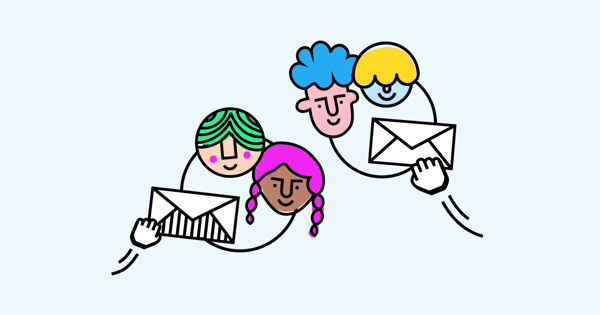It's not easy to be a marketer right now.
Between the death of third-party cookies and new privacy regulations cropping up every few months, targeting is harder than it’s ever been.
Luckily, you have one group to whom you can still send targeted, relevant messages: your own email list.
You own that list. As long as the subscribers have opted-in, you can use segmentation to send them whatever you want, and you’re sure that they see exactly what you want them to see, when you want them to see it.
And yet, so few ecommerce marketers take advantage of this opportunity. In fact, according to our recent report, only one in five ecommerce marketers even use segmentation.
It gets more interesting – when we accounted for all of the revenue earned over the past year, we found that the 20% of marketers who were using segmentation actually earned 80% of the total revenue.
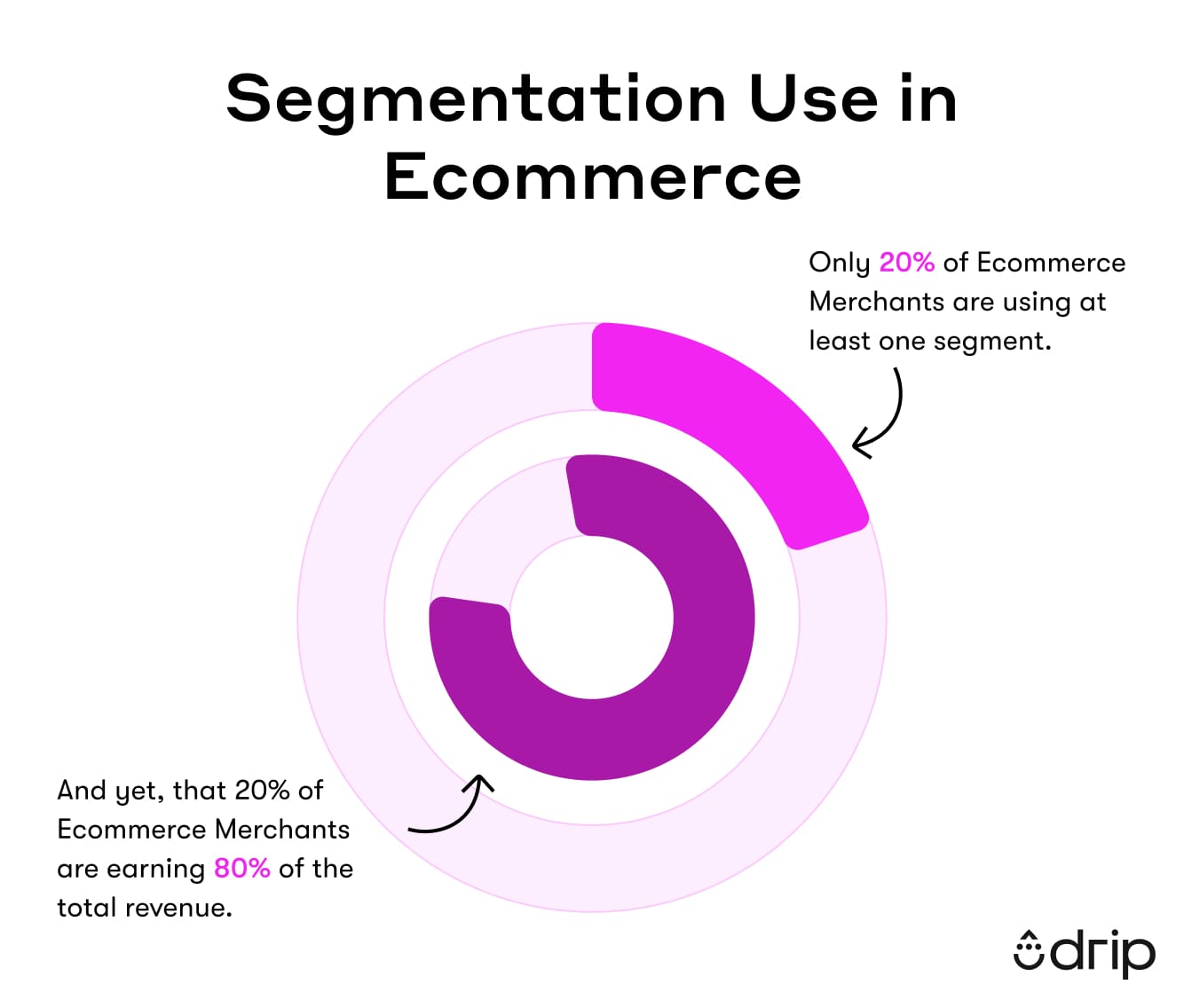 If marketers using segmentation earn so much more than those who don’t, what’s stopping everyone from creating segments and earning more?
If marketers using segmentation earn so much more than those who don’t, what’s stopping everyone from creating segments and earning more?
For many, they don’t know where to start. What kind of segments do you even need? How do you put them in place? How do you even know if they’re working?
In this article, we’re going to give you concrete segments you absolutely should have in place (and we’ll even tell you how to set them up and what to send them).
Table of Contents:
- 1. Your Bullseye Customers: The Ideal Audience for Your Brand
- 2. VIP Customers: The Cream of the Crop
- 3. Hot Prospects: The Ones You Don't Want to Miss
- 4. New People: The Ones with Potential
- 5. Prune List: The Ones that Got Away
- 6. Repeat Purchasers: The Ones That Keep Coming Back for More
- 7. Win Back: The Ones You Can't Lose
1. Your Bullseye Customers: The Ideal Audience for Your Brand
In marketing, we have an acronym for these customers (because of course we do – we have an acronym for everything). This is your ICP, or Ideal Customer Profile.
These customers fit into the most lucrative, or valuable segment you have. They fit your brand, products, and values. These are the people you have in your head when you’re doing anything around your store.
They could fit into a particular demographic, or a sequence of behaviors. Typically, we consider them the people who have purchased from you and are currently engaging with your email campaigns.
So how do you segment them out for relevant messaging?
How to Create a Bullseye Segment:
First, go to People. Then, select Purchase History > Placed an Order > At least once > over all time.
We have the purchase part of the equation in place. Now we need to add in the engagement part.
Add to the segment criteria: Performed an event > Clicked a link > In the last 30 days.
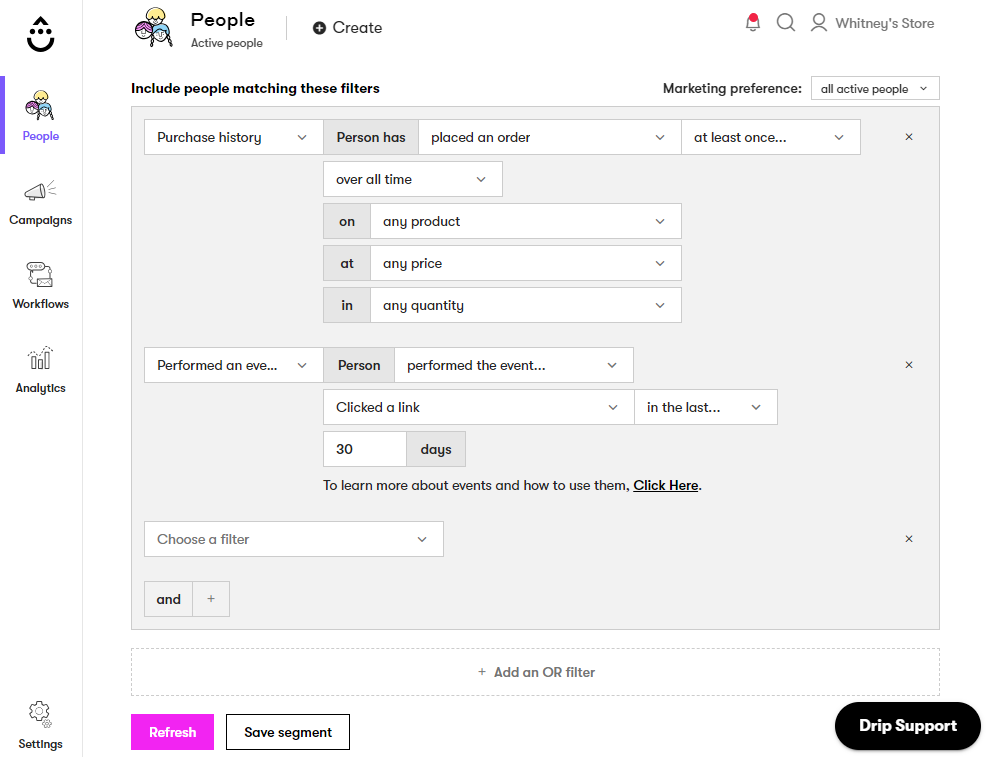 It’s important to note that this segment will depend on your typical purchase cycle. If you have higher-ticket items, your purchase cycle might be a lot longer. You’ll want to adjust and tweak this segment to best fit your customer journey.
It’s important to note that this segment will depend on your typical purchase cycle. If you have higher-ticket items, your purchase cycle might be a lot longer. You’ll want to adjust and tweak this segment to best fit your customer journey.
The most useful part of creating this segment?
You can export it to Facebook Lookalike audiences to find more people just like them.
How’s that for an acquisition hack?
What to Send Bullseye Customers:
For your bullseye customers, your goal is to transform them into VIP customers.
Focus on sending a few of these messages:
- Referral and loyalty automated workflows: These workflows are highly effective when sent to the right people. We want to increase their overall engagement with your store.
- Browse abandonment workflows: They’ve already purchased from you, you can tell they’re interested. Send them reminders and product recommendations for the products that piqued their interest in the first place.
2. VIP Customers: The Cream of the Crop
Your high-value customers are the best of the best – they’re your VIP customers. They’ve purchased often with you, and have likely spent more than any of your other customers.
Normally, to find your best customers, you’d need to do an RFM analysis (recency, frequency, monetary). But, if you have a great marketing automation platform, this is likely automatically done for you.
These are the people who deserve the most appreciation from you. You can’t afford to lose them.
How to Create a VIP Segment:
Much like your bullseye customers, the numbers you choose for this segment are going to depend on your purchase cycle, product pricing, and what constitutes many orders for your store.
Let’s say your best customers have purchased at least five times and have spent $500 or more.
Navigate to People and select Purchase history as your first criteria.
Then, choose Person has placed an order > at least > 5 times> over all time.
Then, keep any product and any quantity the same, but choose at a price greater than > 500.00.
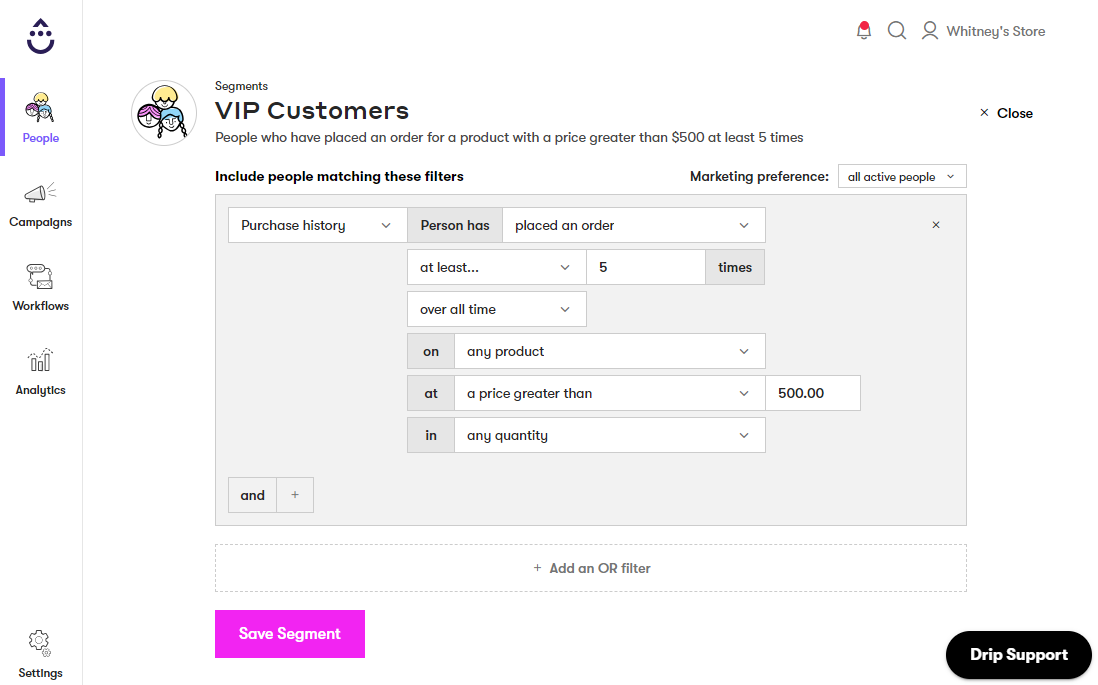 Again, you might have to tweak these numbers to best fit your online store, but this is a great place to get started with your VIP customers.
Again, you might have to tweak these numbers to best fit your online store, but this is a great place to get started with your VIP customers.
What to Send VIP Customers:
For your VIP customers, your goal is to keep them loyal. You want them to come back again and again, and hopefully, tell others about your store and products.
Here’s where you should focus your efforts:
- Keep them coming back with loyalty programs: Show these customers they’re appreciated – offer exclusive VIP discounts, free shipping, free gifts, anything to show them that they’re your favorites.
- Referral and review campaigns: There’s a reason they love your brand, give them the opportunity to tell others why. A sweet incentive will go a long way here.
- Get personal: A personal thank you from the founder can do a lot to show them they’re appreciated. Combine this with a discount on their next purchase to incentivize them.
- Use Onsite popups to show them you care: If they’re VIPs, they likely always have a discount. Put a popup in place using this segment so they get a personalized “Welcome Back” when they visit your store. Remind them of the discount, or offer something special just for them.
- An exclusive look into new products: If they love your products, get their input and feedback. Give them an exclusive peek at what’s coming. You want to make them feel special.
Hot Prospects: The Ones You Don’t Want to Miss
Hot prospects are the customers that aren’t quite customers yet, but they’re showing real intent to purchase.
They visit your site often, and maybe they click your campaigns. They’ve just not yet crossed the finish line. They might be waiting on the right time or the right sale to try out your store.
Regardless, it’s important to try to convert them. Here’s how you can help them along.
How to Create a Hot Prospect Segment:
So here’s the good news – you can create this segment automatically by putting a browse abandonment workflow in place.
Browse abandonment specifically targets customers who have signed up for your emails, and are browsing your store. When a customer browses a particular category, but doesn’t end up purchasing, it’ll send an email to the customer showing the last product they’ve viewed (or product recommendations from the same category).
That’s all you have to do!
The best part is that it will also scoop up customers in other segments that fit into this shopping behavior too.
If you wanted to create it all the same, if nothing else to have a birds-eye view of the people who fit into this segment, here’s how you would do that:
Navigate to People.
Choose Products viewed > Person has viewed > any product > at any price > at least > 2 times > this month.
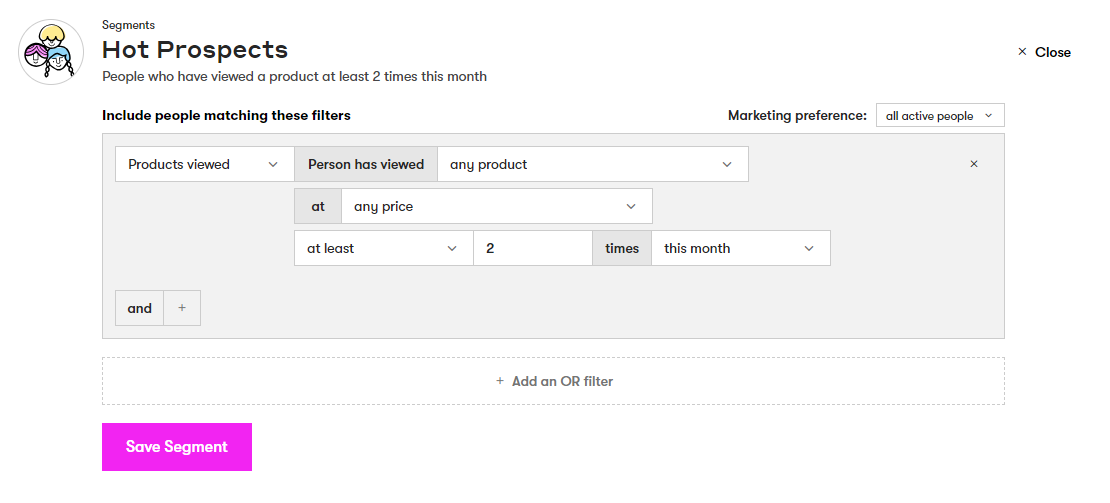 It’s that simple.
It’s that simple.
What to Send Hot Prospects:
Browse abandonment workflows: Think of it as cart abandonment lite, your hot prospects should be tempted to come back and check out more of your products. Check out some more ideas around browse abandonment messages here.
4. New People: The Ones With Potential
Have you ever walked into a brick and mortar shop, and not been greeted?
It would be weird, right?
For ecommerce, it’s actually the same. You want to welcome in your new people and show them what you’re about. You want them to get a good first impression. After all, doing nothing doesn’t win you new customers.
At this point, we’re talking about your customers that signed up to your email list, but have never purchased. Getting that first sign-up is a different strategy altogether.
But once they have, it’s a simple process. Here’s how to pull them into the fold.
How to Create a New People Segment:
More good news: this segment is also automatically created when you create a welcome workflow for your store.
Easy, huh?
But, like hot prospects, maybe you want a view of all the people who have signed up with your store but have never purchased.
Here’s how you’d see that:
What we want are the new sign ups. So go to People.
Choose Performed an event > Person > performed the event > Subscribed to email marketing > at least once.
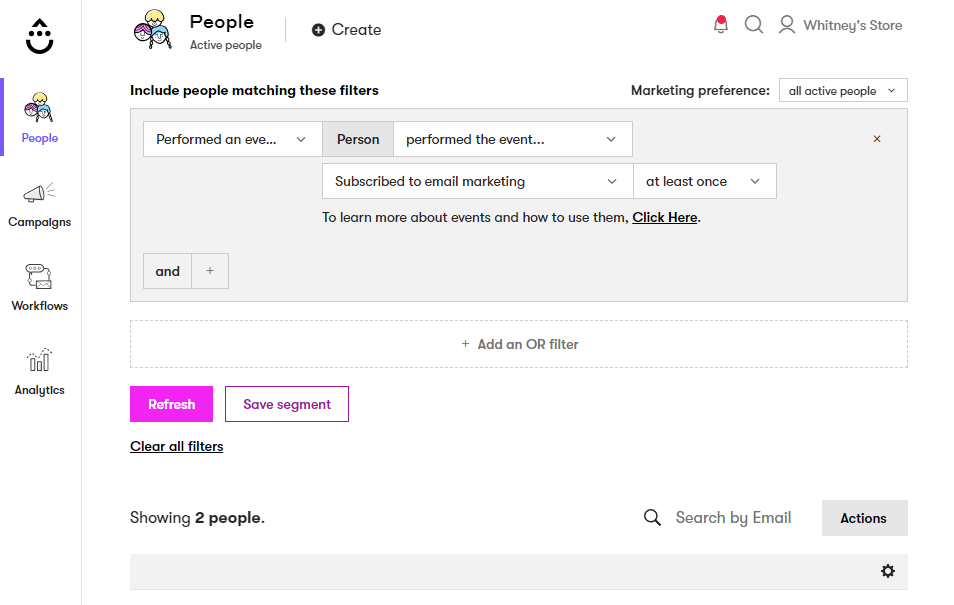 From here, you could get more granular with it. You could select people who have received your welcome emails but haven’t purchased yet. You could section off the people who signed up but never opened an email.
From here, you could get more granular with it. You could select people who have received your welcome emails but haven’t purchased yet. You could section off the people who signed up but never opened an email.
While this particular segment is more automatic, this is a great jumping-off point to create other custom segments.
What to Send New People:
Obviously, a welcome series is your best bet for this segment. But here’s something else to consider: what if you send your welcome series, and they still don’t purchase?
Consider an extended welcome series for those who make it through the first one without buying from you. For example, your typical welcome workflow might have three emails in it:
- Initial welcome discount or incentive you promised at sign-up.
- Product recommendations and a discount reminder.
- Information about your brand and how you create your products.
Perhaps, if they don’t purchase after that cycle, you can extend the cycle by a few more emails. You’d set up the second welcome workflow by making it so anyone exiting the first workflow without making a purchase would automatically end up in this one.
- Social proof with UGC from other customers who loved your products.
- Brand values – why you do what you do. Maybe even a founder’s story if it’s interesting enough.
- A second, slightly higher discount to incentivize the first purchase, mixed with some urgency, à la limited time offer.
Be sure to set up your workflow to have customers exit after the first purchase is made.
5. Prune List: The Ones that Got Away
You can’t win ‘em all. And that’s okay. Your brand isn’t for everyone.
Unless you’re Amazon. In which case, you probably don’t need this article.
Some people just can’t or won’t be converted. They fall out of your sphere, and stop engaging with your messages at all.
At this point, it’s time to cut them loose. Keeping them around can damage your email sender reputation, and even land you in the spam folder.
After all, why keep people on your list that don’t want to hear from you?
Here’s how to splice them out.
How to Create an Inactive Subscribers Segment:
This might be one of the easiest segments to create (other than the ones that are automatically created in workflows).
Simply go to People.
Choose Email Inactivity > Person has received, but not opened or clicked an email in the last > 180 days.
%20%C2%B7%20Drip.png?width=1114&height=475&name=Inactive%20Subscribers%20(Prune%20List)%20%C2%B7%20Drip.png) This way, you can remove subscribers who are dormant for too long, keeping your list fresh and healthy.
This way, you can remove subscribers who are dormant for too long, keeping your list fresh and healthy.
What to Send Inactive Customers:
Honestly, when customers go six months without opening or engaging with you, it’s probably best not to send them anything. You can try for a last-chance re-engagement or winback campaign, but they’ve likely churned for good.
6. Repeat Purchasers: The Ones That Keep Coming Back for More
Repeat purchasers are interesting. They’ve purchased from you more than once, but they’re not quite consistent (or high-spending) enough to be considered VIPs.
But we’re trying to change that.
Anyone who has purchased from you more than once has every potential to become a new VIP. You just have to figure out what they need from you to get there.
After all, you know they’re not a one-off. They’ve come back to purchase once because they enjoyed the experience.
Creating a segment for them can help you push loyalty and transform them into lifelong customers.
How to Create a Repeat Purchaser Segment:
This is also a pretty easy segment to create.
Simply go to People.
Then choose Purchase history > Person has > Placed an order > at least> 2 times > in the last > 1 years > on any product > at any price > in any quantity.
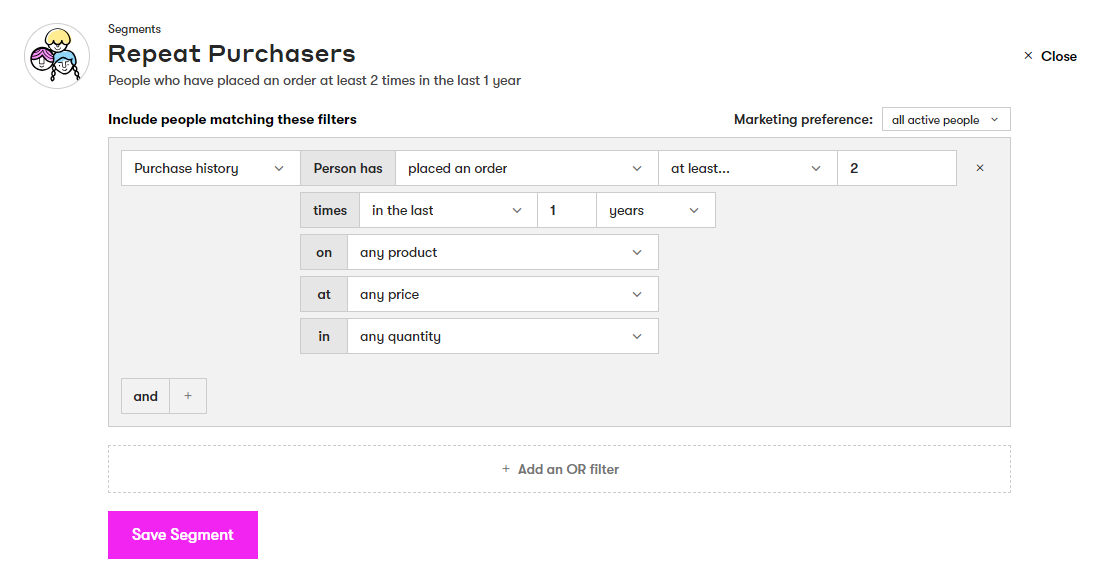
What’s cool about this segment is you can get really tricky with it. For example, if you have a customer that’s purchased from a particular product line, you can send product recommendations from that line.
The foundation is already created for you.
What to Send Repeat Purchasers:
- Post-Purchase thank you: Don’t forget to thank them for any business they give you. You want them to feel appreciated.
- Incentivized review: They clearly enjoy your store – ask them to give you a review. You can incentivize it and also scoop up yet another purchase while you’re at it.
- Post-Purchase product information: Does your product come with a learning curve? Send out the information they need to find success with your product.
- Upsell/Cross-sell: What would go well with the products they’ve purchased? Is there an upgrade that can be found?
- Use Onsite popups to offer a discount on their next visit: Call it customer appreciation – if you want repeat customers to become VIP customers, you have to start treating them like it.
- Follow up the Onsite discount with an email reminder: If they don’t use the popup discount, send an email to remind them. Add in a bit of urgency to close the sale.
7. Win Back: The Ones You Can’t Lose
Unlike your inactive subscribers, your win back subscribers have already made a purchase, even if they haven’t engaged in a while.
This is the segment they land in before they end up in the inactive subscribers segment.
Even though it might not make sense to send out messages to inactive subscribers, win back customers are worth trying to save.
Here’s how you create the segment.
How to Create a Win Back Segment:
This one is a little tricky – but not more than you can handle.
You want someone who hasn’t purchased in a year, but they have purchased before.
So set it up by going to People.
Then select Purchase history > Person has placed an order > at least once > over all time > at any price > in any quantity.
This will give us everyone who has ever purchased. Now we need the lapsed part.
So add Purchase history > Person has not placed an order > at least once > in the last 1 years > on any product > at any price > in any quantity.
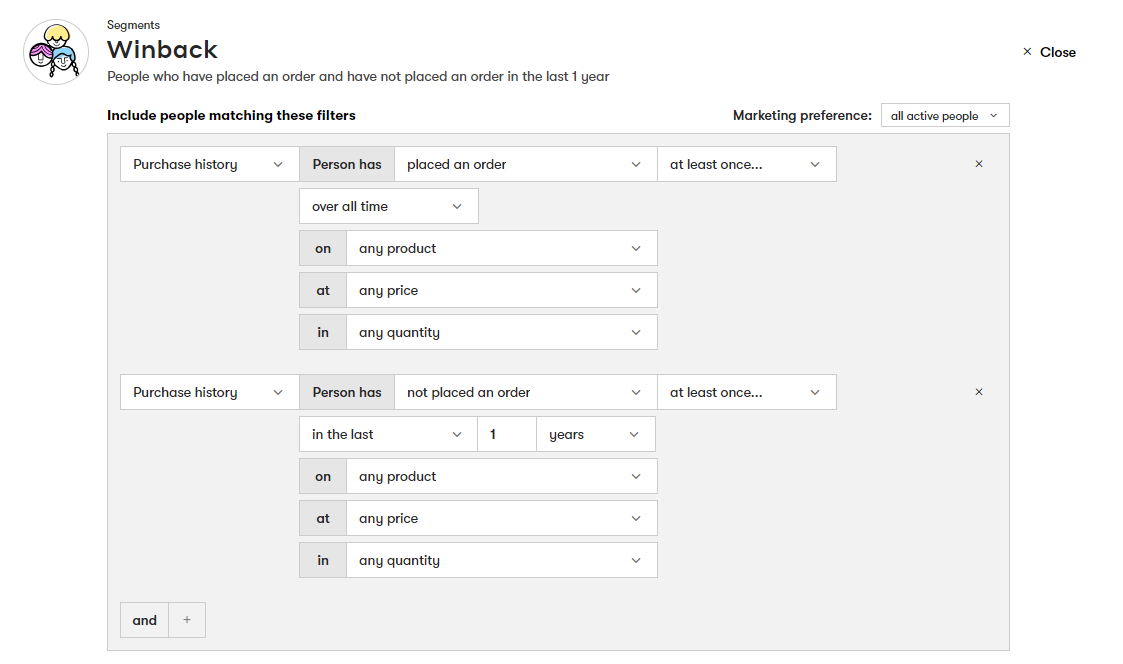 What to Send Win Back Customers:
What to Send Win Back Customers:
A great win back workflow can be what makes the difference between a lapsed customer and an inactive subscriber.
Here’s what you should send:
- Tempt them back with your latest line: What have you released lately? What is related to what they’ve purchased before?
- Bring your best social proof: Nothing encourages a customer to come back and purchase than other happy customers just like them.
- Offer a discount or other incentive: Whether it's an actual discount, or free shipping, or some kind of free gift, sweeten the deal for lapsed customers.
- If all else fails, ask for feedback: You can’t get them all back. If you can’t get them to come back, ask for feedback. They might feel inclined to let you know why they left.
- Add to retargeting on Facebook and Instagram: There’s nothing wrong with sending a few new product retargeting ads for lapsed purchasers. Who knows – you might get them to circle back into your customer journey.
Bringing It All Together
Segmentation isn’t difficult or complicated, it just takes a little knowledge.
And when you know what kind of segments you should have, life just becomes that much easier.
Segmentation gets a bad name from a lot of email service providers who make it unnecessarily complicated. They use developer-oriented language that makes it hard to understand what criteria you’re putting into place.
But if you just know what filters to add, you can make sophisticated segments in a matter of seconds.
Actually, Drip makes a point of putting everything in our platform in plain, easy-to-understand language. We don’t believe in gatekeeping something as critical as targeting your campaigns.
And you’ve seen how easy it is to create all of these segments in Drip. Why not give it a try and see for yourself? You can try Drip absolutely free for 14 days.
